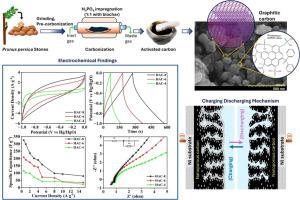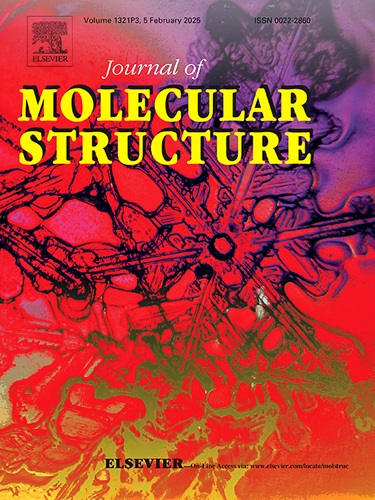将柿子籽石制成的活性炭作为高性能超级电容器的负极材料
IF 4
2区 化学
Q2 CHEMISTRY, PHYSICAL
引用次数: 0
摘要
超级电容器具有高功率密度、长循环寿命和快速充放电能力,因此已成为一种前景广阔的储能解决方案。目前的进展强调使用石墨烯和从废弃生物质中提取的碳基纳米复合材料,形成错综复杂的三维纳米结构,从而显著提高储能能力。本研究调查了正磷酸活性碳(HAC)作为电化学双层超级电容器(EDLC)电极材料的潜力,HAC 取自桃核,在 400 ℃、600 ℃ 和 800 ℃ 温度下碳化。制备的活性炭(AC)的物理化学特征显示其具有纳米多孔形态。布鲁纳-艾美特-泰勒(BET)表面分析表明,在 800 °C 下制备的活性炭(HAC-8)具有最高的比表面积,达到 788.01 m² g-¹。与在较低温度下碳化的样品相比,该样品的碳基质内具有微孔和中孔网络。拉曼光谱显示了突出的石墨化带,X 射线光电子能谱(XPS)分析也证实了这一点。在电流密度为 0.5 A g-1 时,HAC-8 的互联多孔结构产生了 326.9 F g-1 的显著比电容,经过 10,000 次充放电循环后,电容保持率为 97.12%。综上所述,HAC-8 作为超级电容器负极材料具有巨大的应用潜力。本文章由计算机程序翻译,如有差异,请以英文原文为准。

Activated carbon from Prunus persica seed stones as a negatrode material for high-performance supercapacitors
Supercapacitors have emerged as a promising energy storage solution due to their high-power density, long cycle life, and fast charging-discharging capabilities. Current advancements emphasize the use of graphene and carbon-based nanocomposite materials derived from waste biomass, forming intricate 3D nano-architectures that significantly boost energy storage capacity. This research investigates the potential of orthophosphoric acid-activated carbon (HAC) derived from Prunus persica (peach) seed stones, carbonized at temperatures of 400 °C, 600 °C, and 800 °C, as an electrode material for electrochemical double layer supercapacitor (EDLC). Physicochemical characterization of as-prepared activated carbon (AC) revealed the nanoporous morphology. The Brunauer-Emmett-Teller (BET) surface analysis revealed that activated carbon produced at 800 °C (HAC-8) had the highest specific surface area of 788.01 m² g⁻¹. This sample featured a micro-and meso‑porous network within the carbon matrix compared to samples carbonized at lower temperature. Raman spectra showed the prominent graphitization band which is also supported by the x-ray photoelectron spectroscopy (XPS) analysis. The interconnected porous structure of HAC-8 contributed a significant specific capacitance of 326.9 F g−1 at a current density of 0.5 A g−1 with the capacity retention of 97.12 % after a run of 10,000 charging-discharging cycles. Based on these remarks, HAC-8 demonstrated significant potential as a negatrode material for supercapacitor applications.
求助全文
通过发布文献求助,成功后即可免费获取论文全文。
去求助
来源期刊

Journal of Molecular Structure
化学-物理化学
CiteScore
7.10
自引率
15.80%
发文量
2384
审稿时长
45 days
期刊介绍:
The Journal of Molecular Structure is dedicated to the publication of full-length articles and review papers, providing important new structural information on all types of chemical species including:
• Stable and unstable molecules in all types of environments (vapour, molecular beam, liquid, solution, liquid crystal, solid state, matrix-isolated, surface-absorbed etc.)
• Chemical intermediates
• Molecules in excited states
• Biological molecules
• Polymers.
The methods used may include any combination of spectroscopic and non-spectroscopic techniques, for example:
• Infrared spectroscopy (mid, far, near)
• Raman spectroscopy and non-linear Raman methods (CARS, etc.)
• Electronic absorption spectroscopy
• Optical rotatory dispersion and circular dichroism
• Fluorescence and phosphorescence techniques
• Electron spectroscopies (PES, XPS), EXAFS, etc.
• Microwave spectroscopy
• Electron diffraction
• NMR and ESR spectroscopies
• Mössbauer spectroscopy
• X-ray crystallography
• Charge Density Analyses
• Computational Studies (supplementing experimental methods)
We encourage publications combining theoretical and experimental approaches. The structural insights gained by the studies should be correlated with the properties, activity and/ or reactivity of the molecule under investigation and the relevance of this molecule and its implications should be discussed.
 求助内容:
求助内容: 应助结果提醒方式:
应助结果提醒方式:


